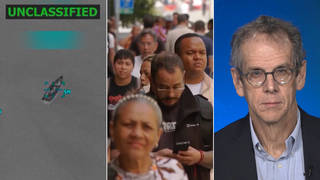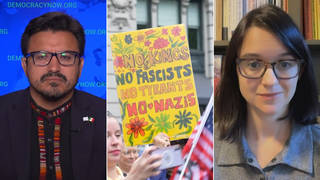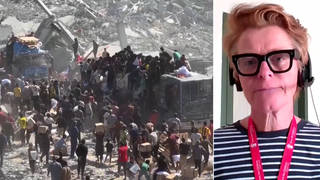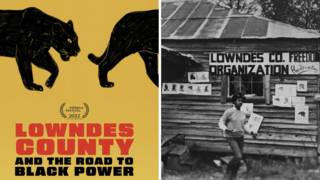
Guests
- Minnijean Brown-Trickeyone of the Little Rock Nine.
- Brent and Craig Renaudco-directors and co-producers of the HBO documentary Little Rock Central: 50 Years Later.
Celebrations are being prepared in Little Rock, Arkansas, for the 50th anniversary of one of the pivotal events of the civil rights era. In September 1957, three years after the Supreme Court’s landmark Brown v. Board of Education ruling, a group of African-American students attempted to desegregate the all-white Central High School in Little Rock. They were escorted into the school by armed National Guard after local authorities vowed to block their entry. We speak with one of the Little Rock Nine, Minnijean Brown-Trickey, and the filmmakers Craig and Brent Renaud, creators of the new HBO documentary “Little Rock Central: 50 Years Later.” [includes rush transcript]
Transcript
AMY GOODMAN: Now, we turn from Jena to Little Rock. Juan?
JUAN GONZALEZ: Well, as the eyes of the nation focus on Jena, Louisiana, today, celebrations are being prepared in Little Rock, Arkansas, for the 50th anniversary of one of the pivotal events of the civil rights era. In September 1957, three years after the Supreme Court’s landmark Brown v. Board of Education ruling, a group of African-American students attempted to desegregate the all-white Central High School in Little Rock. Arkansas’s Governor Orval Faubus defied the Supreme Court’s ruling and ordered the National Guard to prevent the nine teenagers from attending classes. The order sparked a national controversy.
AMY GOODMAN: President Dwight Eisenhower responded by sending Army troops from the 101st Airborne to Little Rock. On September 25, 1957, the armed troops escorted the nine students into the school. The students became known as the Little Rock Nine. One of those students joins us today in our firehouse studio. Her name is Minnijean Brown-Trickey. She was 16 years old at the time. She is featured in the new HBO documentary Little Rock Central: 50 Years Later, produced and directed by two brothers, one of them an alumnus of Central High. That’s Craig and Brent Renaud, Downtown Community Television, here in our firehouse studio. They are all here because the film premiered last night at HBO headquarters in New York. We welcome you all to Democracy Now!
We’re going to begin with Minnijean. Tell us what happened 50 years ago. How did you become one of the Little Rock Nine?
MINNIJEAN BROWN-TRICKEY: It’s very simple. The school board sent — announced to the black school, if you live in the Central High district and you want to go, sign up. And I and three of my friends put our names down. Apparently, there was a selection process, and I’m not really sure how that worked. But on September 3rd, nine kids showed up to enter Central High School. We were rejected by the Arkansas National Guard and the mob that was screaming hatred. We went home, disappointed, returned again on September 23rd. The mob had grown in intensity, even though the Arkansas National Guards had been removed, and we had to come out again. And it was on September 25th that we were accompanied by the 101st Airborne Division to walk into Central High School.
JUAN GONZALEZ: And, of course, it was a Republican president, Dwight Eisenhower, who sent the troops, saying that it was at that time an enormously contentious issue for the federal government to step in and actually confront a local governor. Could you talk about that day, as the federal troops were confronting the officials of the state?
MINNIJEAN BROWN-TRICKEY: Well, our lawyer was Thurgood Marshall, and he explained to us, this is a constitutional conflict. You’re in the middle of something amazing. We shall see what happens. And, of course, as it turned out, it’s probably one of the most important American history stories, because it involves everything. It’s presidents — can I think — I was 16. I was fascinated by the whole process, and I’ve continued to be fascinated by it for my entire life.
AMY GOODMAN: I mean, it’s a remarkable story when you see the white mobs outside. Mobs are the parents of the other kids at the high school. Tell us who you nine were. You knew two, three of the other of the students?
MINNIJEAN BROWN-TRICKEY: Well, we lived in the segregated society of Little Rock, Arkansas, Jim Crow South. The rules were: You have to know your place. You drink out of the colored water fountains. We had just gotten maybe to the front of the bus. So, going to school, even though we weren’t — I don’t think we were thinking about it, seemed to be a way of opening up some of that, I think. We were really naïve — I will admit that — and we did know each other, because we went to the black schools in Little Rock, so we knew each other. And we did it independently, in some ways, in different rooms, in different homes. It was pretty amazing.
JUAN GONZALEZ: What were the conditions in Central High, compared to the school you had gone to previously, in terms of the actual learning environment, the buildings themselves, the kinds of textbooks and the material that you had available to you?
MINNIJEAN BROWN-TRICKEY: Well, Central High was named the most beautiful high school in America when it was built. Huge. It’s huge. It covers a couple of blocks. It’s got every facility. It’s got a gym. It’s got a track. It has a stadium. And it just seemed to be — really have a great contrast to where I was going to school. So why not? It was in my neighborhood.
AMY GOODMAN: So on September 25th, describe the scene. You came in a military vehicle?
MINNIJEAN BROWN-TRICKEY: Yes. We were picked up by a military vehicle. We squeezed into this station wagon. At the front were, I guess, anti- — I never saw military equipment, but anti-aircraft guns or machine guns in the front and in the back. When we stepped out of the station wagon, we were surrounded by 101st Airborne guards, who had fixed bayonets and helmets, and walked into history.
AMY GOODMAN: Were the other white students in school at that point?
MINNIJEAN BROWN-TRICKEY: They were. And it was almost as if it could be a movie set. We were just surrounded by soldiers and feeling very safe for the first time. It was unbelievable.
JUAN GONZALEZ: And in the days that followed, once you got settled into the school, how did the white students relate to you and the others who had integrated the school?
MINNIJEAN BROWN-TRICKEY: Well, I think the Little Rock Nine decided that we would sort of make it really clear. We say that 75 to a hundred people who were just constantly violating our bodies and minds, 20 nice kids, and 1,900-plus silent witnesses, the sort of Elie Wiesel — people who stood by, watched and said nothing.
AMY GOODMAN: What was being screamed at you by the parents outside? And did you recognize any of them?
MINNIJEAN BROWN-TRICKEY: No, I didn’t. And I was fascinated by the fact that many of them were women. And they were screaming — I love it — “Integration is communism,” “Go back to Africa,” as well as all the sort of negatively descriptive terms. But I was fascinated by “Go back to Africa.” I had no relationship to Africa in my mind. I didn’t really understand that. But “Integration is communism” was a strange thing to hear. And it just really got very loud and sounded very scary. So that’s my great memory of Central High, is the fear. And I know that some of the other Little Rock Nine say that that was the day they were most afraid, and they don’t think they could handle being that afraid again.
AMY GOODMAN: We’re going to go to break, and when we come back, we’ll come 50 years forward to Central High today, to Arkansas Central. We will talk with you and the Renaud brothers about this documentary on this half-century later. Stay with us.
[break]
AMY GOODMAN: We’re going to turn now to two excerpts of the HBO documentary Little Rock Central. This is Brandon Love, an African-American student leader at Little Rock Central.
BRANDON LOVE: Tonight, I get sworn in as student body president here at Central. Being a black student, it means something, because what happened 50 years ago, you always have to think about it. I mean, it’s something that you think about every day, because these are the same steps that almost 50 years ago, you know, they wouldn’t let the black students in. You know, the National Guard had to escort everybody in, these same steps, the very doors. It’s a big deal.
AMY GOODMAN: The documentary also features footage of Minnijean Brown-Trickey returning to Little Rock Central and talking to students.
MINNIJEAN BROWN-TRICKEY: So imagine, just for the heck of it, imagine what it feels like, a veteran of the civil rights movement, to sit here and watch this class configure itself. If you look at, for instance, Little Rock today, we still line up on two sides of color. And if we keep on saying and talking about and doing the same things that we’ve been doing forever, we’re going to stay the same. And I’m really sorry for us.
AMY GOODMAN: Can you tell us what it was like coming back to school after 50 years, Minnijean?
MINNIJEAN BROWN-TRICKEY: Coming back to school and watching children sit on two sides of the room, black kids, white kids — the number of other ethnicities is low at Central High — to come into a room and see that broke my heart. But I decided my heart was broken because they didn’t know better. They hadn’t been told better. They were doing what we’ve sort of prepared them to do over time. So, in a way, everybody says, “Well, you know, those kids have a responsibility,” and I don’t blame the kids. They know little about the desegregation crisis. They have little understanding or knowledge of all the movements that have taken place in this country. So, in fact, they’re behaving as they should, with being miseducated, uneducated and somehow diminished in their ability to think about these issues.
JUAN GONZALEZ: Well, as we’ve been reporting on the Jena Six in Louisiana — and it’s not just in the South.
MINNIJEAN BROWN-TRICKEY: Right.
JUAN GONZALEZ: I reported in the Daily News just yesterday of an extreme racial bias incident that happened right here in New York City on September 11th, where an entire basketball team, the Manhattan Community College basketball team, leaving practice on September 11th, was attacked by a mob of whites twice. Several of them, including their coach, beaten as they were yelling “Slavery time!” and “N—-er!” to the group — to the students. And the police ended up arresting some of the whites finally, but not charging them with anything other than misdemeanor assault. And now the coach and the team are attempting to demand hate crime charges against these folks, and they feel that the police department is underplaying it, quite the opposite of what’s happening in Jena.
So when you see these incidents occurring and involving students in the North and the South, what’s your sense of what was accomplished by all of the battles that occurred in the ’50s and the ’60s?
MINNIJEAN BROWN-TRICKEY: That’s an amazing question, and I really don’t have the answer. But when I see these young men and the film they made, I know that there was a shift in consciousness, in that they thought deeply about some of these issues. So, obviously, it’s had great impact.
AMY GOODMAN: Well, Craig and Brent, let’s turn to you, two brothers. You grew up in Little Rock, now well-known filmmakers. You did Arkansas Goes to War, that remarkable series of documentaries. You embedded with the Arkansas National Guard. Craig, you’re an alumnus of Central High, of Little Rock Central. How did you go about doing this film?
CRAIG RENAUD: Well, having graduated from Central High School, you know, the school remains prominent in your mind once you leave Little Rock. And ever since we became filmmakers, we’ve really wanted to go back and make a documentary at Central High School. We had actually approached the school a number of years ago about doing a documentary. The timing wasn’t right then. And when we came back from Iraq with the 50th anniversary upon us, we were fortunate enough to be given full access to go back to the school 50 years later after integration.
AMY GOODMAN: Brent, you sat in that school for months before picking up a camera?
BRENT RENAUD: Yeah. I mean, we’re not experts on education, and we don’t pretend that we have — you know, even know necessarily the problems or know the answers to it. So what we did is we sat in the classrooms. We got to know the teachers for months before we ever brought a camera in.
And there were two things that people were really telling us. One was that it was an incredible school, ranked now in the top 20th in the nation in Newsweek for its advanced placement programs. But a lot of teachers, especially after we got to know them, kept coming to us and said, “There’s another story here also. There’s something besides the PR story. And we challenge you guys to look a little bit deeper.” And so, what we did is, rather than necessarily taking either of those positions, we picked a nice cross-section of kids from diverse backgrounds and let them tell the story of what Central is like for them today.
JUAN GONZALEZ: And what’s the racial makeup of the school today, and also of the teaching staff at the school?
CRAIG RENAUD: The school itself is about 52, 53 percent African American and just under 50 percent Caucasians at the school, and then a small sampling of other minorities at the school, as well.
JUAN GONZALEZ: What about the teacher corps?
CRAIG RENAUD: The teacher corps, I’m not sure of the statistics of the teachers at the school.
AMY GOODMAN: One of the things you point out in this documentary — you show just by being in the classes — is the segregation that comes with AP, with advanced placement classes. Explain how that works. I mean, you were a student there, too, Craig.
CRAIG RENAUD: Yeah. I graduated from Central in 1992, and, you know, I took AP classes, and the situation was very similar then. And we were actually quite surprised to come back into the school 15 years later and find that these issues were still persisting in the school.
And basically, what you have at Central is you have a school that’s ranked top 20 in the country for the advanced placement classes, but on the whole you find very few African Americans in these classes. And so, that was something that we looked at in the film, and it’s something that people were talking about openly in the film and very candidly.
BRENT RENAUD: And because it is so well regarded —
AMY GOODMAN: Brent.
BRENT RENAUD: — the top students in Little Rock, most of whom have affluent backgrounds, seek that school out. And so, they go there. So what you have in issue is where maybe other places in the country and urban inner-city schools, there’s been a lot of white flight away from the schools. They actually come and seek the school out. And that’s why you get a fairly decent makeup when you — white and black. But they’re seeking it out for those advanced placement classes, and as a result, they’re almost entirely white students from very affluent backgrounds.
JUAN GONZALEZ: One of the things that’s been coming out recently — you mentioned a white flight that occurred, and throughout the South, actually, after the integration was implemented, many whites sent their kids to private schools. Now, you’re getting a redistricting of a lot of these schools to bring whites back in, but there appears to be a sort of a re-segregation of some of these districts as a — in an effort to bring whites back into the public school system. Did the film touch at all on any of these — the current issues that are occurring in terms of segregation and desegregation?
CRAIG RENAUD: No, we didn’t go that broad, in terms of the overall issues of segregation in the school districts. Interestingly enough, in Little Rock right now, you have an issue going on in the school board, which now, for the first time in 50 years, has a majority African-American school board, and there are some divisions and battles that are going on there involving the superintendent and people in the community, and a lot of the conversations that come out of that are similar issues. You know, you have a lot of people in the white community that, I think, fear that those same issues will occur in Little Rock if certain things aren’t dealt a certain way. And then you have other people concerned that there’s a large population of the school, or the African-American students, who aren’t being properly served in these districts. So you do have this resurfacing in Little Rock, as well.












Media Options